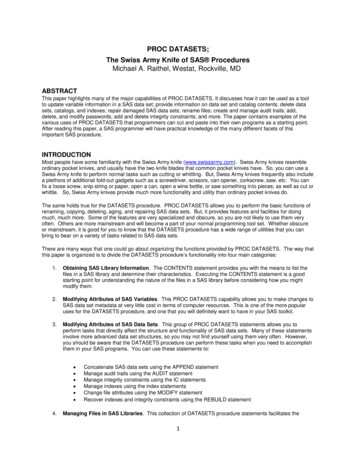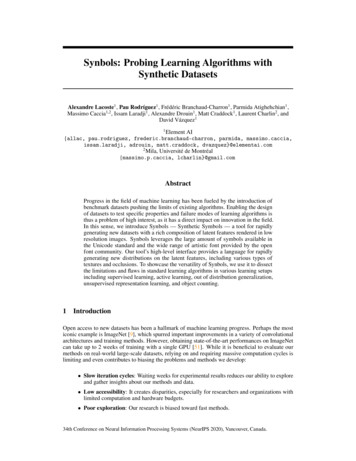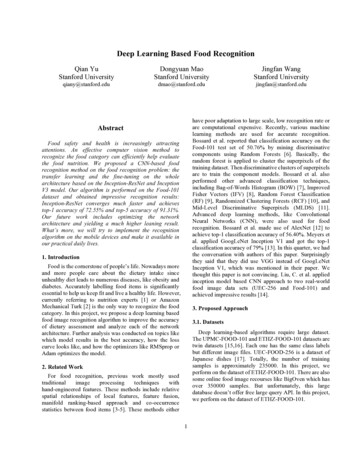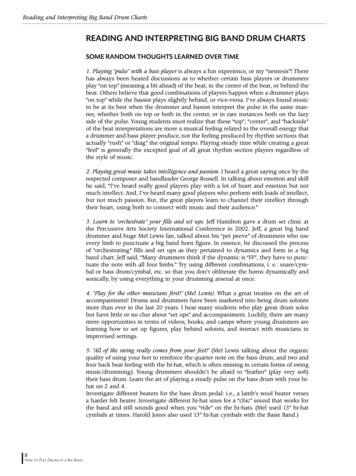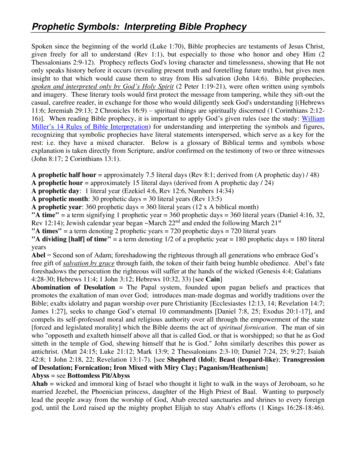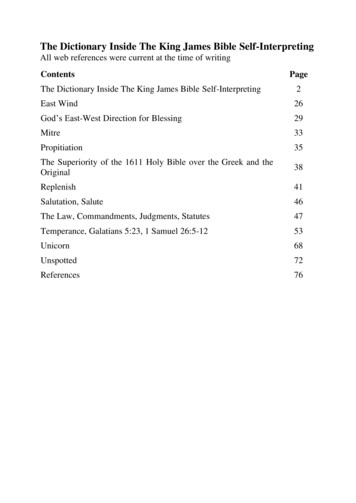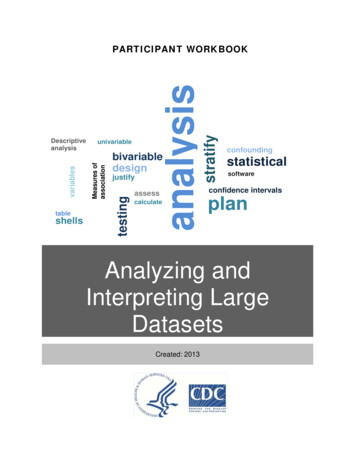
Transcription
gntestingtableunivariableMeasures ARTICIPANT WORKBOOKconfoundingstatisticalsoftwareconfidence intervalsplanAnalyzing andInterpreting LargeDatasetsCreated: 2013
Analyzing and Interpreting Large Datasets. Atlanta, GA: Centers for Disease Control andPrevention (CDC), 2013.
ANALYZING AND INTERPRETING LARGE DATASETSTable Of ContentsINTRODUCTION . 4LEARNING OBJECTIVES . 4ESTIMATED COMPLETION TIME . 4TARGET AUDIENCE . 4PRE-WORK AND PREREQUISITES . 4ABOUT THIS W ORKBOOK AND THE ACTIVITY W ORKBOOK . 4ICON GLOSSARY . 5ACKNOWLEDGEMENTS . 5SECTION 1: OVERVIEW . 7INTRODUCTION TO DATA ANALYSIS . 7STEPS IN ANALYZING NCD DATA . 7KEY CONCEPTS . 8SECTION 2: DESCRIPTIVE ANALYSIS . 15OVERVIEW OF DESCRIPTIVE ANALYSIS . 15UNIVARIABLE ANALYSIS . 16KEY POINTS TO REMEMBER . 22BIVARIABLE ANALYSIS . 26SECTION 3: ANALYTIC EPIDEMIOLOGY . 36OVERVIEW . 36CONCEPTS OF ASSOCIATION . 36KEY POINTS TO REMEMBER . 40STATISTICAL SIGNIFICANCE TESTING . 43CONFIDENCE INTERVALS. 45KEY POINTS TO REMEMBER . 46STRATIFIED ANALYSIS . 47EFFECT MEASURE MODIFICATION . 48CONFOUNDING . 52SUMMARY OF EMM AND CONFOUNDING . 57KEY POINTS TO REMEMBER . 58SECTION 4: INTERPRETING AND REPORTING YOUR FINDINGS . 63RESOURCES . 71APPENDICES . 72APPENDIX A . 73PARTICIPANT WORKBOOK 2
ANALYZING AND INTERPRETING LARGE DATASETSAPPENDIX B . 75PARTICIPANT WORKBOOK 3
ANALYZING AND INTERPRETING LARGE DATASETSIntroductionLEARNING OBJECTIVESAt the end of this module, you will be able to: conduct and interpret descriptive analysis and analytic epidemiology, summarize your findings, and prepare a report.ESTIMATED COMPLETION TIMEThe workbook should take approximately 18 hours to complete.TARGET AUDIENCEThe workbook is designed for FETP fellows who specialize in NCDs;however, you can also complete the module if you are working in infectiousdisease.PRE-WORK AND PREREQUISITESBefore participating in this training module, you must complete training in: Basic epidemiology and surveillance Basic analysis Statistical software program (your country is using) Creating an analysis plan Managing data (creating a data dictionary and cleaning data)ABOUT THIS WORKBOOK AND THE ACTIVITY WORKBOOKThe format of the Participant Workbook consists of one overview sectionand three additional sections. You will read information about analyzing andinterpreting large datasets and complete six exercises to practice the skillsand knowledge learned. At the end of the training module, you willcomplete a skill assessment which combines all skills taught.PARTICIPANT WORKBOOK 4
ANALYZING AND INTERPRETING LARGE DATASETSICON GLOSSARYThe following icons will be used in this workbook:Image TypeImage MeaningPencil - an activity, exercise, assessment or case studythat participants completeActivity IconStop - a point at which you should consult a mentor orwait for the facilitator for further locally relevantinformation about the topicStop IconTip – key idea to note and rememberTip IconResource / Website Icon- a resource or website thatmay provide further information on a given topicResource IconACKNOWLEDGEMENTSMany thanks to the following colleagues from the Centers for DiseaseControl and Prevention for providing detailed feedback and guidance: Fleetwood Loustalot, PhD, FNP, Andrea Neiman, MPH, PhD(Division for Heart Disease and Stroke Prevention) and EdwardGregg, PhD (Division of Diabetes Translation), for creating thehypertension case study. Lina Balluz, Sc.D., MPH, from the Office of Surveillance,Epidemiology and Laboratory, Division of Behavioral SurveillancePARTICIPANT WORKBOOK 5
ANALYZING AND INTERPRETING LARGE DATASETS Richard Dicker, MD, MS, from the Centers for Global Health, Divisionof Public Health Systems Workforce Development Italia Rolle, PhD, RD, Office on Smoking and Health, Global TobaccoControl Branch Roberto (Felipe) Lobelo, MD, PhD, Division of Diabetes TranslationPARTICIPANT WORKBOOK 6
ANALYZING AND INTERPRETING LARGE DATASETSSection 1: OverviewINTRODUCTION TO DATA ANALYSISIn the Creating an Analysis Plan module, you learned how to create tableshells to use when you analyze data. The Managing Data moduleexplained how to create a data dictionary to use during data analysis andhow to clean the data. In this module, you will learn how to conductdescriptive analysis and analytic epidemiology and how to interpret yzingandInterpretingLargeDatasetsDataintoActionIf you look at the “five W’s of journalism” below, descriptive and analyticepidemiology can help answer the following: What Who Where When Why/HowClinicalPersonPlaceTimeCause, mode oftransmission, alyticEpidemiology(Determinants)STEPS IN ANALYZING NCD DATAWhen analyzing data, you will begin with simple analysis (descriptive) andmove to the complex.As you recall, the main steps in analyzing large datasets is as follows:PARTICIPANT WORKBOOK 7
ANALYZING AND INTERPRETING LARGE DATASETS1. Conduct basic descriptive analysis:Describe the sample population by person, place, and timecharacteristics. Summarize variables using population-level frequencies,and calculate stratified frequencies across important sub-groups (if any).The purpose of descriptive analysis is to characterize the studyparticipants by age and sex distribution, where they are from, bydistribution of risk factors, etc. You will calculate frequency-of-diseasemeasures, such as prevalence.2. Compute and interpret measures of association:Determine the strength of association between an exposure variable andan outcome variable. If there are two or more populations, considercomparing their demographic data to determine whether they weredifferent before the study/analysis was conducted.3. Conduct confidence intervals and/or statistical significance testing:Use t-tests for continuous data and chi-square for non-continuous data.4. Assess for effect measure modifcation:A situation in which a third variable exhibiting statistical interaction byvirtue of its being antecedent in the causal process under study.5. Assess the effect of potential confounders:A situation in which a measure of the effect of an exposure on risk isdistorted because of the association of exposure with other factors thatinfluencethe oucome under studyKEY CONCEPTSIn non-communicable diseases, we tend to use large datasets and conductsecondary data analysis. The size of the database depends on the numberof records (persons) and variables. Commonly used datasets include: Vital registration (number of deaths, cause of death for a country) Demographic health surveys (DHS) used in low and middleincome countries WHO STEPS survey The National Health and Nutritional Examination survey (NHANES-U.S.)PARTICIPANT WORKBOOK 8
ANALYZING AND INTERPRETING LARGE DATASETS The Behavioral Risk Factor Surveillance System (BRFSS U.S., Jordan)The databases typically are representative of a population either through acensus (all persons included) or a sample (number of people selected torepresent the population). For example, NHANES 1999-2000 interviewed9,965 persons in the United States and the database includes hundreds ofvariables. Before attempting data analysis for large datasets, it is veryimportant you locate the survey sampling methodology, questionnaire, datavariable dictionary and any other supporting documentation.ActivityActivity #1:Go to the NHANES links below and describe what key information theyprovide. Write your response in the space below. Then check yourresponse with Appendix A.1. texam99 00.htm;2. http://www.cdc.gov/nchs/data/nhanes/nhanes 03 04/nhanes analyticguidelines dec 2005.pdfPARTICIPANT WORKBOOK 9
ANALYZING AND INTERPRETING LARGE DATASETSOnce you have your data, determine if the data include: All persons in the population of interest (census) A sample representative of the population (e.g. probability simplerandom sample, random sample or cluster sampling) A sample not representative of the population (e.g. non-probabilityconvenience sampling or purposive sampling)Knowing this information will inform the statistics you will use during dataanalysis.PARTICIPANT WORKBOOK 10
ANALYZING AND INTERPRETING LARGE DATASETSSurvey CommandsFor samples that are from complex survey designs, you must use theappropriate survey commands and not the regular commands in yourstatistical survey software.Before setting these commands, always look at the raw data beforeapplying the survey commands using the non-survey commands. Thiswould be the first step before performing univariable analysis to view thedata. In addition, for complex survey designs, you must set the weightcommand, strata, and psu (primary sampling unit) commands whencomputing representative estimates of the variables.After examining the data and finalizing your data analysis plan, proceed withusing the survey commands to obtain estimates that account for thecomplex survey design and weighting. These estimates, although from asample, are now representative of the population that was sampled.Population Parameters and Sample StatisticsThe following table is helpful when we talk about population parameters andsample statistics. The measures you use depend on the type of data youare analyzing.PARTICIPANT WORKBOOK 11
ANALYZING AND INTERPRETING LARGE DATASETSTable 1: Population Parameters and Sample Statistics 1Population parameterN: Number of observations in thepopulationSample statisticn: Number of observations in thesampleNi: Number of observations inpopulation ini: Number of observations in sampleiP: Proportion of successes inpopulationp: Proportion of successes in samplePi: Proportion of successes inpopulation ipi: Proportion of successes in sampleiμ: Population meanμi: Mean of population ix: Sample estimate of populationmeanxi: Sample estimate of μiσ: Population standard deviationσp: Standard deviation of ps: Sample estimate of σSEp: Standard error of pσx: Standard deviation of xSEx: Standard error of xLet us examine standard error and standard deviation in more detail.1Taken from: .PARTICIPANT WORKBOOK 12
ANALYZING AND INTERPRETING LARGE DATASETSStandard DeviationThe standard deviation reflects the variability of the distribution of acontinuous variable. To estimate the standard deviation:1. Calculate the weighted sum of the squares of the differences of theobservations in a simple random sample from the sample mean2. Divide the result obtained in #1 by an estimate of the population sizeminus 13. Take the square root of the result obtained in #2Standard Error of the MeanThe standard error of the mean is an indication of how well the mean of asample estimates the mean of a population. To estimate the standard error,divide the estimated standard deviation by the square root of the samplesize.ResourceFor an example of standard ication of WeightsIn addition to population parameters and survey statistics, another importantconcept you need to know when using complex survey data is the use ofweights.Use weights to account for complex survey design (including oversampling),survey non-response, and post-stratification. When a sample is weighted, itis representative of the population. A sample weight is assigned to eachsample person. It is a measure of the number of people in the populationrepresented by that sample person. Fortunately, there are several softwarepackages for survey analysis that compute sampling errors correctly forweighted survey estimates from complex sample designs.It is important to use weighted data when you need to generalize thefindings from your study to the whole population. . Weighting is a techniqueusually done by statistician to assure representation of cetain groups in thesample. It is a process that removes non-response and non -coverage bias.PARTICIPANT WORKBOOK 13
ANALYZING AND INTERPRETING LARGE DATASETSIf you look at the graph below, you will see that the unweighted interviewsample from NHANES 1999-2002 is composed of 47% non-Hispanic whiteand Other participants, 25% non-Hispanic Black participants, and 28%Mexican American participants. The US population in 2000, in contrast, was78% non-Hispanic white and Other, 13% non-Hispanic black, and 9%Mexican American. Therefore, unweighted estimates for any survey itemassociated with race/ethnicity would be biased if weights were not used,because estimates would not be representative of the actual U.S. civiliannoninstitutionalized population.Figure 1: NHANES 1999-2002, Race-Ethnicity DistributionStopLet the facilitator or mentor know you are ready for the group discussion.PARTICIPANT WORKBOOK 14
ANALYZING AND INTERPRETING LARGE DATASETSSection 2: Descriptive AnalysisOVERVIEW OF DESCRIPTIVE ANALYSISDescriptive analysis involves computing frequency distributions (also knownas univariable analysis) and simple cross-tabulations (bivariable analysis).This helps you characterize the population under study and understand theoccurrence of outcomes and exposures by person, place, and timecharacteristics.The objectives of descriptive analysis are to: Describe and assess the health status of a population Evaluate patterns of disease and allow comparisons over time and place Provide a basis for planning and evaluation of services Identify problems to be studied by analytic methods, including testinghypotheses related to those problemsConducting univariable data analysis involves analyzing one variable at atime in a dataset, such as sex, age, or education. You can assess therange, mean, median and mode of each continuous variable and the rangeand frequency distribution of discrete variables. You will then examine theprevalence by demographics (e.g., age, marital status, location).Conducting bivariable analysis involves analyzing the relationship betweentwo variables. You will compare the outcome populations of interest interms of demographic characteristics (e.g., comparing differences in age,gender, ethnicity, income, or location between cases and controls).Depending on the questions you need answered, descriptive analysis canreveal information related to the factors of person, place, and time in thepopulation of interest such as: The characteristics of the population, such as age, gender,where they live (e.g., urban or rural) The prevalence of the population affected by the disease,outcomes, or exposures The prevalence of risk factors among the population When the events of interest occurred, such as monthly or yearlyPARTICIPANT WORKBOOK 15
ANALYZING AND INTERPRETING LARGE DATASETSTipRemember to use the table shells you created in your analysis plan whendescribing the characteristics from descriptive analysis.For this section of the module, you will practice conducting descriptiveanalysis for the hypertension case study and your own country data.UNIVARIABLE ANALYSISWhen you cleaned your dataset, you looked at key descriptive variables(such as age, sex, marital status, education level, and occupation). Nowyou will examine the results and organize them into tables and graphs sothat you can compare the variables.Run FrequenciesA frequency distribution shows the number of observations located in eachcategory of a categorical variable (e.g., sex, level of education, maritalstatus). For continuous variables, such as age, frequencies are displayedfor values that appear at least one time in the dataset.Frequency distributions provide an organized picture of the data, and allowyou to see how individual scores are distributed on a specified scale ofmeasurement. For instance, a frequency distribution shows whether thedata values are generally high or low, and whether they are concentrated inone area or spread out across the entire measurement scale.You can structure frequency distributions as tables or graphs, but eithershould show the original measurement scale and the frequenciesassociated with each category. Datasets with very large sample sizes canpotentially have a long list of different values for continuous variables;therefore, it is recommended that you use a graphic format to check thedistribution for continuous variables, and either frequency tables or graphicforms for nominal or interval variables.PARTICIPANT WORKBOOK 16
ANALYZING AND INTERPRETING LARGE DATASETSFor large datasets, analyze continuous variables (such as age) bydetermining the mean, median, standard deviation and interquartile range(IQR). Analyze nominal variables (such as gender) by using percentages.Table 1 has been adapted from the Jordan BRFSS, 2004 to show frequencydistribution by education level:Table 2: Distribution by Education (Jordan BRFSS, 2004)All ParticipantsN 3342EducationF%Never attendedschool49114.7Primary school93628.0Secondary ortechnical school148144.3University or more43413.0ActivityActivity #2:Discuss with a colleague the conclusions you would make based on Table2. Check your answers with those in Appendix A.PARTICIPANT WORKBOOK 17
ANALYZING AND INTERPRETING LARGE DATASETSCreating Intervals or CategoriesThe mean and median of continuous variables provide useful information;however, there are times when you may want to group the continuousvariable data into logical intervals or categories. You will then compare thefrequency distributions of the new categories.Consider these guidelines when creating intervals: Create intervals that are mutually exclusive and include all of thedata Use a relatively large number of narrow intervals initially. You cancombine intervals again after you look carefully at the distributions. Use natural or biologically meaningful intervals when possible. Forexample, look at standard or frequently used age groupings whenconsidering age. Create a category for unknowns if relevantIn the example below (table 3), the frequency distribution yielded a long listof values.Table 3: Distribution by Age (Sample Data) 3171353563354Blaikie, N.(2003). Analyzing Quantitative Data. London: Sage.PARTICIPANT WORKBOOK 10.9
ANALYZING AND INTERPRETING LARGE 460100.0If there is no clear natural or standard interval, you can: Divide the data into groups of equal size Base the intervals on mean and standard deviation Divide the range into equal class intervalsThe example in table 4 shows how the data was grouped in five categoriesof relatively even distribution.Table 4: Distribution by Age in Five Categories (Students) 3Age18192021-2223 ing ResponsesSometimes, you have to eliminate certain responses in your analysis tocreate a two-part response. For example, a question originally coded toinclude “Yes”, “No”, and “Don’t Know” responses is a three-part response. Ifyou have very few “Don’t Know” responses, you may choose to eliminatethem. You should be very careful when eliminating responses because youwill lose information. If there are a large number of a certain response (suchas “Don’t Know”), then it would not be appropriate to eliminate thatinformation.3Blaikie, N.(2003). Analyzing Quantitative Data. London: Sage.PARTICIPANT WORKBOOK 19
ANALYZING AND INTERPRETING LARGE DATASETSTipIf there is only a very small number of responses, then eliminating theinformation can be an appropriate choice to improve your interpretationof the variable.PrevalenceRecall that prevalence is a proportion that expresses the presence of adisease or other characteristic at a specific point in time. To calculate theprevalence of a disease or other health outcome, divide the number ofcases in a population at a specific time by the total population at that periodof time. Similarly, to calculate the prevalence of a risk factor such assmoking or other characteristic, divide the number of people with that riskfactor at a specific time by the total population at that period of time.For example, one of the research questions for the 2004 Jordan BehavioralRisk Factor Survey was: To determine prevalence of frequent mentaldistress (FMD) (a proxy for mental illness), using number of mentallyunhealthy days among adult Jordanians. Health Related Quality of Life question:“Now thinking about your mental health, which includes stress,depression, and problems with emotions, for how many days duringthe past 30 days was your mental health not good?” Frequent Mental Distress was defined as 14 days of mental healthnot good.ActivityActivity #3:Discuss with a colleague the conclusions you would make based onFigure 2 below. Then check your responses with those in Appendix A.PARTICIPANT WORKBOOK 20
ANALYZING AND INTERPRETING LARGE DATASETSPercentage (%)Figure 2: Percent Mentally Unhealthy Days (out of the past 30 days):Jordan 20041009080706050403020100801560 days1-13 days14 days (FMD)Mentally unhealthy daysPARTICIPANT WORKBOOK 21
ANALYZING AND INTERPRETING LARGE DATASETSTo analyze the data by certain demographics, such as age, education andincome, you will conduct bivariable analysis (discussed in the next section).StopLet the facilitator or mentor know you are ready for a group discussion.He or she will review key concepts of conducting univariable analysisbefore you complete Exercise 1.KEY POINTS TO REMEMBERUse the space below to record any key points from the facilitator-leddiscussion:Practice Exercise #1 (Estimated time: 1 hour)Background:For this exercise, you will work individually, in pairs or in a small group tocompute univariable analysis.Instructions:1. Read figure 32. Answer the questions that followPARTICIPANT WORKBOOK 22
ANALYZING AND INTERPRETING LARGE DATASETS3. Ask a facilitator to review your workFigure 3: Hypertension case studyThe initial analysis should provide you with a general description of thesample characteristics. Exploring the data may include assessing mean,median, range, minimum and maximum values, and other descriptivecharacteristics. As the data are from a complex design, you would want toassess crude estimates and weighted estimates. Revisiting the researchquestions are appropriate. If you are describing the distribution and burdenof hypertension in County X, consider the variables to select, and whatvariables may influence your outcome of interest.1. Assess the variables in the tables below using descriptive statistics(e.g., frequency, mean, median, standard deviation, minimum,maximum). Consider assessing variables graphically (e.g., histogram,scatterplot, etc).Variable:FrequencyMeanMedianStandard deviationMinimumMaximumAge (years)Variable:Systolic blood pressure (mmHg) (1stmeasure)FrequencyMeanMedianStandard deviationMinimumMaximumPARTICIPANT WORKBOOK 23
ANALYZING AND INTERPRETING LARGE ionMinimumMaximumBody Mass Index ( kg/m2)2. The dataset that you are using was derived using a complex design,and the data are nationally representative of the civilian population inCountry X. Sample weights and sample design variables are frequentlyneeded when analyzing data from a complex design survey. Comparecrude (i.e., unweighted) and weighted estimates. Examine the crude(i.e., unweighted) and weighted estimates for variables in the tablebelow and fill in the answers.UnweightedestimateAge (mean)Male y MassIndex (kg/m2)(mean)PARTICIPANT WORKBOOK 24StandardDeviationWeightedestimate(95% CI)StandardError
ANALYZING AND INTERPRETING LARGE DATASETSHypertension(%)Optional Question:3. After you have explored the data, you can set up the first table usingadjusted data. It is important to provide an adequate description of yoursample and include relevant health and health outcome variables.Consider what variables would be presented in a descriptive table in amanuscript. (Note: Review questionnaire for available variables).What variables would you include in the table below? After you haveselected the variables, perform the descriptive analysis and add theinformation to the table.NPercentStandardErrorPARTICIPANT WORKBOOK 25
ANALYZING AND INTERPRETING LARGE DATASETSBIVARIABLE ANALYSISAs you recall, bivariable analysis involves either: Establishing similarities or differences of the demographiccharacteristics (e.g., age, gender, ethnicity, income, or location)and/or exposure characteristics (e.g., drug use, environmentalexposure, diet, exposure to other ill persons, family history ofdisease) Describing patterns or connections between such characteristicsSimple Cross-TabulationsA cross-tabulation (cross-tab) is a two or more dimensional table thatrecords the number (frequency) of respondents that have the specificcharacteristics described in the cells of the table. You can use cross-tabs tovisually assess whether independent and dependent variables might berelated. You can also use cross-tabs to find out if demographic variablessuch as sex and age are related to the second variable.Use cross-tabs when you want: To look at relationships among two or three variables A descriptive statistical measure to determine whether differencesamong groups are large enough to indicate some sort of relationshipamong variablesRefer to an example of cross-tabs in Table 5 below.PARTICIPANT WORKBOOK 26
ANALYZING AND INTERPRETING LARGE DATASETSTable 5: (Adapted from) Chronic Disease Risk Factors Among Participantsin Medical Examination, by Selected Demographic Characteristics,Behavioral Risk factor Surveillance System, Jordan, 2004.SexDiabetesSelf-reportedMeasuredTotal% (SE)Male% (SE)Female% (SE)9.8 (1.95)17.7 (2.38)8.6 (1.36)16.5 (1.38)9.0 (1.16)16.9 (1.24)ActivityActivity #4:Discuss with a colleague the conclusions you would make based onTable 5. Then check your responses to the possible answers inAppendix A.Let’s look at another example from the same Jordan BRFSS from 2004. Intable 6 below, we are examining the relationship between age groups andhigh blood pressure (self-reported and measured).PARTICIPANT WORKBOOK 27
ANALYZING AND INTERPRETING LARGE DATASETSTable 6. (Adapted from) Chronic Disease Risk Factors Among Participantsin Medical Examination, by Selected Demographic Characteristics,Behavioral Risk Factor Surveillance System, Jordan, 2004.18-34% (SE)High BloodPressureSelfreportedMeasuredAge Groups35-4950-64% (SE)% (SE)2.5 (.095)11.3 (1.87)9.4 (2.30)28.3 (3.53)35.9(4.05)55.2(3.78) 65% ctivityActivity #5:Discuss with a colleague the conclusions you would make based on table6. For example, which age group was more likely to self-repo
Analyzing and Interpreting Large Datasets. Atlanta, GA: Centers
